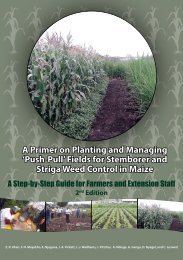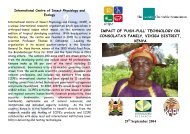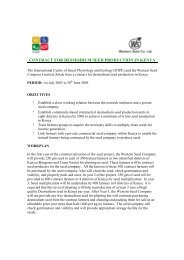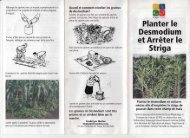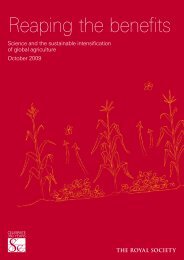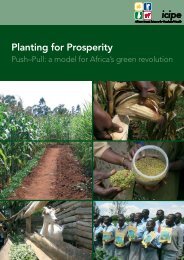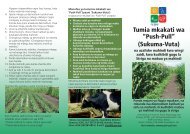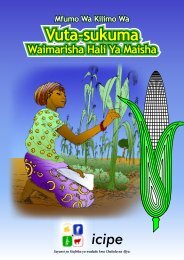Biology and management of economically important ... - Push-Pull
Biology and management of economically important ... - Push-Pull
Biology and management of economically important ... - Push-Pull
You also want an ePaper? Increase the reach of your titles
YUMPU automatically turns print PDFs into web optimized ePapers that Google loves.
720 KFIR ET AL.<br />
They speculated that low densities, which may occur after the release <strong>of</strong> an arrhenotokus<br />
parasitoid, might decrease chances <strong>of</strong> mate finding, thus leading to possible<br />
extinction. However, C. flavipes <strong>and</strong> C. sesamiae mate with their siblings before<br />
dispersal (21, 144, 157), <strong>and</strong> thus Allee effects will not influence establishment.<br />
A high host-searching ability has been suggested as a factor involved in the<br />
success <strong>of</strong> C. flavipes. Even at low host densities, C. flavipes successfully located<br />
stem borer hosts (219). The high host-searching success <strong>of</strong> C. flavipes may in<br />
part be due to its behavior <strong>of</strong> entering tunnels in plant stems to attack stem borer<br />
larvae (182). Many larval parasitoids <strong>of</strong> stem borers remain on the outside <strong>of</strong> the<br />
stem <strong>and</strong> attack their hosts by drilling, or locating breaches through the stem, with<br />
their ovipositor (182). This strategy may be effective for attacking stem borers in<br />
small-stemmed wild grasses, but in relatively larger-stemmed cultivated grasses,<br />
the length <strong>of</strong> the ovipositor may limit the number <strong>of</strong> hosts susceptible to attack (74).<br />
ACKNOWLEDGMENTS<br />
Thanks to the Illinois Natural History Survey, Department <strong>of</strong> Entomology, Department<br />
<strong>of</strong> Natural Resources <strong>and</strong> Environmental Sciences, <strong>and</strong> the Office <strong>of</strong><br />
International Programs <strong>of</strong> the University <strong>of</strong> Illinois for support during a sabbatical<br />
leave at INHS by the senior author while this article was prepared. Thanks<br />
to Tharina Bird <strong>and</strong> Kerstin Krüger (ARC-PPRI) for help in sorting out the references.<br />
R. Wiedenmann (INHS) constructively commented on an early draft <strong>of</strong> the<br />
manuscript.<br />
Visit the Annual Reviews home page at www.AnnualReviews.org<br />
LITERATURE CITED<br />
1. Abu JF. 1986. <strong>Biology</strong> <strong>and</strong> Control <strong>of</strong> the<br />
Insect Pests <strong>of</strong> Sorghum in the Southern<br />
Guinea Savanna Zone <strong>of</strong> Nigeria. Zaria,<br />
Nigeria: Inst. Agric. Res. Samaru. 23 pp.<br />
2. Adenuga AO. 1977. Comparative methods<br />
<strong>and</strong> the economics <strong>of</strong> control <strong>of</strong><br />
stem borers (Lepidoptera: Noctuidae <strong>and</strong><br />
Pyralidae) on local maize, Zea mays.<br />
Proc. Ann. Conf. Nigerian Soc. Plant Prot.<br />
(NSPP), 7th, pp. 52–53. Occasional Publ.,<br />
Nigerian Soc. Plant Prot.<br />
3. Adesiyun AA. 1983. Some effects <strong>of</strong> intercropping<br />
sorghum, millet <strong>and</strong> maize on<br />
infestation by lepidopterous stalk-borers,<br />
particularly Busseola fusca. Insect Sci.<br />
Appl. 4:387–91<br />
4. Adesiyun AA, Ajayi O. 1980. Control <strong>of</strong><br />
the sorghum stem borer, Busseola fusca,<br />
by partial burning <strong>of</strong> the stalks. Trop. Pest<br />
Manag. 26:113–17<br />
5. Adeyemi SAO, Donelly J, Odetoyinbo<br />
JA. 1966. Studies on chemical control <strong>of</strong><br />
stem borers <strong>of</strong> maize. Nigerian Agric. J.<br />
3:61–66<br />
6. Ajala SO. 1993. Population cross diallel<br />
among maize genotypes with varying<br />
levels <strong>of</strong> resistance to the spotted stem<br />
borer Chilo partellus (Swinhoe). Maydica<br />
38:39–45<br />
7. Ajala SO, Saxena KN, Chiliswa P. 1995.<br />
Selection in maize (Zea mays L.) for resistance<br />
to the spotted stem borer (Chilo<br />
partellus (Swinhoe)). Maydica 40:137–<br />
40



